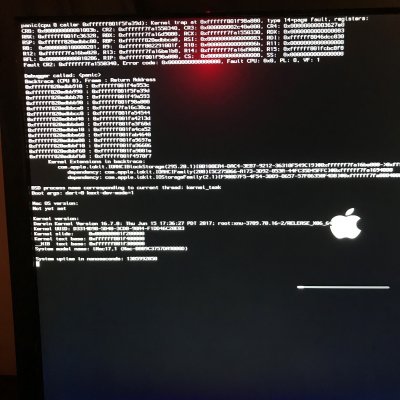- Joined
- Dec 19, 2011
- Messages
- 9
- Motherboard
- Gigabyte GA-Z170XP-SLI
- CPU
- i7-7700k (Delidded oc to 5ghz)
- Graphics
- GTX 1060 (Asus-Dual-06G)
- Mobile Phone
So after updating to 10.12.6 I had a kernel panic that was quickly resolved after removing the "HackrNVMeFamily-10_12_5.kext" and "IONVMeFamily.kext" files. Upon trying to reinstall those kexts and to reactive my Samsung 960 NVMe SSD I got hit with another kernel panic and removing those kexts has not resolved the issue. I may have accidentally removed another kext while trying to get the two NVMe related ones removed.
To be honest, I don't remember the exact procedure I used to activate the NVMe drive (which contains my Win 10 Partition. Mac is on a Samsung 850 m.2 SSD) but I see that the version of Mac that it is compatible with is in the file name.
I have full access to the Mac File System within Windows but cannot boot into MacOS without getting hit with a kernel panic. attached is a photo of the error I am getting. I do not know exactly what I am doing with this but it seems to me that MacOS is having an issue with AHCI support on the boot partition or with a kext related to that. Any help is much appreciated. Thanks
To be honest, I don't remember the exact procedure I used to activate the NVMe drive (which contains my Win 10 Partition. Mac is on a Samsung 850 m.2 SSD) but I see that the version of Mac that it is compatible with is in the file name.
I have full access to the Mac File System within Windows but cannot boot into MacOS without getting hit with a kernel panic. attached is a photo of the error I am getting. I do not know exactly what I am doing with this but it seems to me that MacOS is having an issue with AHCI support on the boot partition or with a kext related to that. Any help is much appreciated. Thanks

